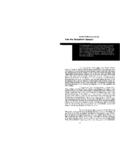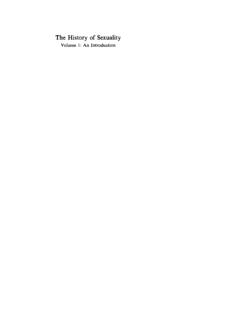Transcription of Michel Foucault’s Discipline & Punish: The Birth of the ...
1 foucault sDiscipline & Punish: The Birth of the PrisonReader/WorkbookStephen ShapiroWhile you read foucault s Discipline and Punish, I d like you to do a few with a pen in hand and notepaper by your parts that you think may be key statements or summaries of foucault s position, passages you don t understand,and sections that you might want to return tables of the oppositions and explanations that foucault uses (for example, what characterizes the difference betweena terror and Discipline society).This workbook should give you some examples of how to do m asking you to do this in order to practice focusing on the hot spots of a big text, the key passages that you (or othercritics) might use to ground and signpost their making a skeleton of the argument, you ll be able to think more clearly about what points you want to further explore,take issue with, or complicate in your own thought and After you read a section, take stock of the argument s about what foucault argued in the section and what questions he poses that he ll move to explain in the nextsection.
2 In other words, think of the text as a series of questions and answers, which speak to one another across thespace of the section breaks. Conceptualizing the text as a dynamic argument, rather than static thesis (a statement thatgets said and then insistently repeated, as if reiteration equals persuasion) will be useful when we turn to literary , and other cultural documents, often pose, wittingly or not, a question or problem that it tries to answer by usingthe terms or language it initially proposed. Literary narratives think in print about social issues and they have solutions, other times they run aground. It s this difference that makes reading texts in light of acommon problematic you actually read the foucault section, you might want to review this workbook in order to help notice theargument. But don t take my outline as gospel. Vary the ways in which you use the workbook, sometimes reading it afteryou read the text, sometimes Think of practical examples of what foucault is Consider how foucault s arguments may (or may not) illuminate your own personal experiencesand is writing a history, but he calls it a history of the present.
3 His motive is to look at the past in order to explainour present condition. Does this narrative speak to you as a subject in modern society? Does it feel relevant? If youdisagree with foucault , why did you disagree? general overview of foucault s historical narrative in Discipline and Punish might be somethinglike this:Early modern society (here meaning before the 18C but after the medieval age. the period of absolutist states, the ancienregime) conceptualized power in a vertical, top-down fashion. The king expressed his total power through spectacles ofpunishment and terror to display his overwhelming authority and ability to crush any popular resistance. If a prisoner waspublicly tortured, the point to be made was that the king (as a surrogate for God) had complete and utter power over what we may think, there was a rational system to early modern aristocratic torture; it was not random and it hadcertain rules, or internal logic.
4 Torture justified itself by the act of confession, which was the ultimate proof of a prisoner sguilt. But the king s authority could also be challenged by the prisoner refusing to confess, since at the moment of torture,when the criminal should be the weakest, the prisoner was able to (symbolically) confront the king as an individual. This wasdangerous because it suggested that the prisoner could be equal to royalty, and if equal, then perhaps the king s socialsuperiority (and behind it ancien regime society) could also be challenged. (Ridley Scott s Gladiator enacts this). Foucaultimplicitly argues that we can study something like the procedures of punishment as a means of analyzing how societiesconstitute king s terror system began to come under two pressures in the eighteenth century. First, the common people (plebeians)no longer saw the person on the scaffold as their enemy, but as a (class) comrade; the spectacles of punishment becameopportunities for popular dissent, and these events became increasingly risky as they might catalyze a riot that would seriouslythreaten royal power (as would happen in the French Revolution).
5 The second pressure came from the middle class, who plotted to replace the nobility. The increasing challenges to early moderncodes of crime by plebeians gave the rising bourgeoisie (the Third Estate) an opportunity to undermine the powers of thearistocracy (the First Estate) in two ways. First, the middle class encouraged popular illegality by not prosecuting crimes sothat actions by the lower classes would weaken the nobles treasury and symbolic authority (prestige). In this way, the middleclass used the lower classes as their instrument to covertly confront the king s , the middle class used the enlightenment language of humanism (benevolence, charity) to criticize the king s brutality, as a means of delegitimizing the old social order and advertising the middle class moral superiority as a means ofjustifying their political right to rule. Humanism as a rhetoric allowed the middle class to portray the king as the degeneration,not epitome, of civil middle classes attacked the old justice system was because they were angry that king denied them juridico- administrativeoffices and the social status that came with these offices.
6 The bourgeoisie were also upset about the seeming irrational,confusing overlap between the various courts and tax officials, since a businessman s worst nightmare is not having to paytaxes, but never being able to calculate exactly what taxes are owed. Finally, the gentle way of punishment was proposed bymiddle class writers to create career opportunities as jurists, lawyers, medics, psychologists, sociologists, as the peoplewho earn a living through working with ideas rather than physical labor. foucault argues that the middle class also changed thecriminal codes to seem more universal because the bourgeoisie felt confident that they could avoid punishment through better(financial) access to defense lawyers, problem that the middle class faced, however, was that after the fall of the ancien regime, the popular classes, now freedfrom royal authority, might turn against the middle class by robbery, warehouse theft, or riots against (food) speculators.
7 [Keepthis argument in mind when you read Marx]. Therefore, penality had to be changed to protect the middle class s profits fromthe mob. Hence the middle class created a new system of punishment and Discipline , which sought to control the population bycreating oppositions within them. These oppositions came about by creating disciplined souls through a variety ofinstitutions, like schools, hospitals, and prisons, that work by oppositions such as normal/abnormal or presents a history of the changes in criminal codes and punishments to explore why we moved from a bodilypunishment of torture to a gentle punishment of prison sentences. He argues that we did not stop torturing people becausewe became more enlightened. Instead, he claims that the codes of justice are always biased because they represent andmaterially enact social power. The difference between early modern society and modern one isn t that modern society is morecivilized; it is just that punishment in pre-modern times had a logic that came out of a society where the king and nobilityruled.
8 Punishment in modern society has a different logic because modern society is bourgeois, its controlled by the middleclass, and the middle class has different social agendas than the nobility. Both systems create certain conceptions of justice, thebody, and visual codes, but the use these objects in different ways, and that s the rub. (It might be worth thinking about what anon-aristocratic, non-bourgeois criminal code might look like). uses a history of punishment in order to illustrate the larger social movement of power from the aristocracy to themiddle classes. The reason why he is interested in punishment is that it exemplifies how modern society creates subject (identities) subjects by disciplining them through the intersection of social definitions of normality, material institutions(like the school), and the judgment of professionals (intellectuals) in order to stabilize bourgeois society against non-bourgeois( laboring class) revolt.
9 The story foucault tells is the move from public, physical punishments to private, invisiblediscipline of a soul . This tale will interest us since the course s texts emerge from the same time period as foucault talksabout, from the eighteenth to nineteenth centuries. Do our texts support or contradict foucault s argument (or some mixture ofthe two)? This is partly what we ll discuss as the course what follows, I ll try to highlight what seem to be the main arguments and some useful/key passages. All page notes are toPenguin text s original title is Surveiller et English this is translated as Discipline and Punish, but, as you can see, the French also emphasizes the act of 1. Torture1. The Body of the CondemnedThis section acts as the overview of the book s argument. You might want to re-read it after you ve finished reading the bookto see how foucault telegraphs the arguments that he will later contrasts Damiens public torture (Damiens attempted to kill Louis XIV) with Faucher s timetable to illustrate thehistorical spectrum of his study, from public spectacle to the elimination of physical pain in Argues that we too readily interpret the disappearance of public torture as a sign of our collective humanization.
10 foucault says that we should see the removal of torture as a marker of larger social that at the end of the 18th century and start of the 19th, two process of punishment began to disappear:1. torture as a public spectacle (be it public executions or public work gangs), and2. physical now becomes secretive; it is hidden from the public s view and abstract . No one is responsible fordelivering punishment because the apportioning of blame is redistributed. Sets up the distinction between the disfigured body and the corrected one ( moral orthopedics [10]). Punishment is nolonger the tortured, dismembered, amputated body, symbolically branded on face of shoulder, exposed dead or alive to publicview. The body as the major target of penal repression disappeared. 9. Argues that the change came because public punishments became to be seen as unfair as the crime itself, alongside thiswas a shift in the nature of punishment from the visible to the invisible, from the domain of more or less everydayperception to abstract consciousness , from visible intensity to inevitability.















